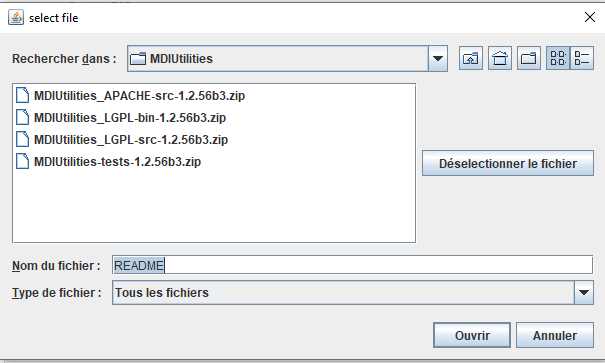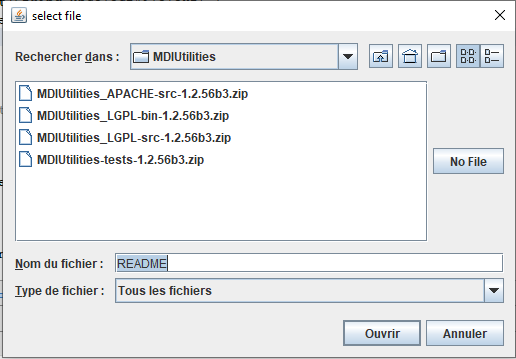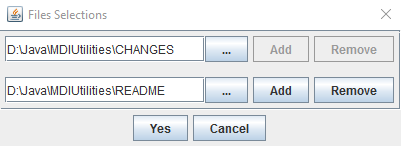File choosers
1 JOptionalFileChooser
1.1 Text on the optional button
1.2 Restricting the file select input to a single directory
2 JFileSelector
2.1 Example
3 JMultipleFileSelector
3.1 Example
1.1 Text on the optional button
1.2 Restricting the file select input to a single directory
2 JFileSelector
2.1 Example
3 JMultipleFileSelector
3.1 Example
Several classes extend the Swing
For example, for the following code:

The following Locale languages are supported: The following Locale languages are supported:
It is also possible to force the text on the button by using the JOptionalFileChooser.setUnselectFileText(String) method. For example:

For example:
The JFileSelector class is a file chooser backed by a component. The important methods of the backing


The JMultipleFileSelector class is a multiple file chooser backed by a component, where the order of the files is clearly specified by the user. Contrary to the standard Java

JFileChooser class:- The UnsortableFileChooser class return the selected files in the order in which they were added by the user rather than the order chosen by the
JFileChooserclass - The JFileSelector class is a file chooser backed by a component. See JFileSelector
- The JMultipleFileSelector class is a multiple file chooser backed by a component, where the order of the files is clearly specified by the user. See JMultipleFileSelector
JOptionalFileChooser
The JOptionalFileChooser class is a file chooser which allows to unselect a file.- By default it works exactly as a regular file chooser
- If the JOptionalFileChooser.setHasOptionalFiles(boolean) method is set to
true, then if will present an additional button in the interface to allow to unset the file
For example, for the following code:
JOptionalFileChooser fileChooser = new JOptionalFileChooser(); fileChooser.setHasOptionalFiles(true); File selFile = new File("D:\\Java\\mdiutilities\\README"); fileChooser.setSelectedFile(selFile); fileChooser.setDialogTitle("select file"); if (fileChooser.showOpenDialog(null) == JFileChooser.APPROVE_OPTION) { File file = fileChooser.getSelectedFile(); System.out.println("file: " + file); }You will have the following GUI:

Text on the optional button
By default theJOptionalFileChooser GUI will use the default Locale language of the platform.The following Locale languages are supported: The following Locale languages are supported:
- English:
en - French:
fr - Italian:
it - Spanish:
sp - Portuguese:
pt - German:
de - Norwegian:
no - Japanese:
ja - Chinese:
zh
JOptionalFileChooser component. By default this is the default platform Locale, but it is possible to force the Locale by using the Component.setLocale(Locale) method on the JOptionalFileChooser component.It is also possible to force the text on the button by using the JOptionalFileChooser.setUnselectFileText(String) method. For example:
JOptionalFileChooser fileChooser = new JOptionalFileChooser(); fileChooser.setHasOptionalFiles(true); File selFile = new File("D:\\Java\\mdiutilities\\README"); fileChooser.setSelectedFile(selFile); fileChooser.setUnselectFileText("No File"); fileChooser.setDialogTitle("select file"); if (fileChooser.showOpenDialog(null) == JFileChooser.APPROVE_OPTION) { File file = fileChooser.getSelectedFile(); System.out.println("file: " + file); }You will have the following GUI:

Restricting the file select input to a single directory
The JOptionalFileChooser(File, boolean) and JOptionalFileChooser(String, boolean) methods allow to restrict the file select input to the specified current directory.For example:
JOptionalFileChooser chooser = new JOptionalFileChooser(<current directory>, true);
JFileSelector
Main Article: JFileSelector
The JFileSelector class is a file chooser backed by a component. The important methods of the backing
JFileChooser have associated methods in this class which defer to the underlying JFileChooser. For example:- The JFileSelector.addActionListener(ActionListener) method allows to listen to file selections

Example
The following code creates a JFileSelector:JFrame f = new JFrame("test"); JFileSelector fs = new JFileSelector(); fs.setCurrentDirectory(new File(System.getProperty("user.dir"))); fs.addActionListener(new ActionListener() { @Override public void actionPerformed(ActionEvent e) { System.out.println("Action : "); JFileChooser chooser = (JFileChooser)e.getSource(); File file = chooser.getSelectedFile(); } }); f.getContentPane().add(fs); f.pack(); f.setVisible(true);You will obtain the following result:

JMultipleFileSelector
Main Article: JMultipleFileSelector
The JMultipleFileSelector class is a multiple file chooser backed by a component, where the order of the files is clearly specified by the user. Contrary to the standard Java
JFileChooser, or the JFileSelector, each of the files can be selected in its specific directory.
Example
The following code creates a JMultipleFileSelector:JFrame f = new JFrame("test"); JMultipleFileSelector fs = new JMultipleFileSelector(); fs.setCurrentDirectory(new File(System.getProperty("user.dir"))); fs.addActionListener(new ActionListener() { @Override public void actionPerformed(ActionEvent e) { System.out.println("Action : "); JMultipleFileSelector selector = (JMultipleFileSelector)e.getSource(); File[] files = selector.getSelectedFiles(); } }); f.getContentPane().add(fs); f.pack(); f.setVisible(true);You will obtain the following result:

×
![]()
Categories: Packages | Swing